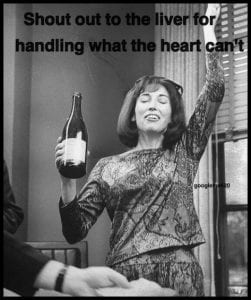 Memes have become synonymous with modern pop culture. Accounts dedicated just to posting memes exist on every social media platform and according to many, often outnumber posts by friends and family members in feeds. It is easy to understand how they became so popular; they are funny, and often speak a relatable truth. In a society where it is increasingly less cool to talk about your feelings, it is less pressure to double tap a meme and keep scrolling, instead of type out a whole post and wait nervously to see what social feedback will be like. While this can make you feel like you are not alone in your opinions or quirks, it can also make bad behavior seem relatable or encouraging.
Memes have become synonymous with modern pop culture. Accounts dedicated just to posting memes exist on every social media platform and according to many, often outnumber posts by friends and family members in feeds. It is easy to understand how they became so popular; they are funny, and often speak a relatable truth. In a society where it is increasingly less cool to talk about your feelings, it is less pressure to double tap a meme and keep scrolling, instead of type out a whole post and wait nervously to see what social feedback will be like. While this can make you feel like you are not alone in your opinions or quirks, it can also make bad behavior seem relatable or encouraging.
One example of this is alcohol related behavior and consumption. Dr. George Koob of the National Institute on Alcohol Abuse and Alcoholism discusses in his presentation that a fundamental difference between male and female alcohol consumption is the reason behind drinking. Dr. Koob asserts that men drink for positive reinforcement – because they enjoy the experience and sensation that comes with being drunk, while women drink for negative reinforcement – to lessen anxiety or to combat a tough day or uncomfortable experience. Meme culture has really grasped onto this concept and flourished into something that perhaps it shouldn’t have. This is evident by many memes that hint at, or outright state, alcohol should be consumed as a fix for anxiety or stress.
 Take for example this meme: “It’s not alcoholism, it’s a stress intervention”. This suggests when dealing with high or continued stress, alcohol consumption is a perfectly legitimate way to handle it. Generally, interventions are considered good or necessary, as a way of remediating a poor habit or behavior. Sending the message that alcohol should be the appropriate response to a high stress environment is dangerous, especially since it reinforces the negative reinforcement mindset women already have. Will Ferrell is featured in this meme and as a renowned comedian and celebrity his likeness attracts attention. While of course he did not endorse this meme, his image will increase its popularity and viral nature. This brings us to another danger of memes. They were first popularized by taking still images with interesting facial reactions and adding a funny descriptive caption. This eliminates any sourcing, citing, or required condoning from subjects of these images. There are now ‘meme generators’ where you can insert any photo and add a captain, or have one created for you. With zero regulation, and zero current copyright precedence, memes can be created to push any idea, behavior, or concept with minimal backlash. This in turn only encourages the churning out of ‘funny’ memes.
Take for example this meme: “It’s not alcoholism, it’s a stress intervention”. This suggests when dealing with high or continued stress, alcohol consumption is a perfectly legitimate way to handle it. Generally, interventions are considered good or necessary, as a way of remediating a poor habit or behavior. Sending the message that alcohol should be the appropriate response to a high stress environment is dangerous, especially since it reinforces the negative reinforcement mindset women already have. Will Ferrell is featured in this meme and as a renowned comedian and celebrity his likeness attracts attention. While of course he did not endorse this meme, his image will increase its popularity and viral nature. This brings us to another danger of memes. They were first popularized by taking still images with interesting facial reactions and adding a funny descriptive caption. This eliminates any sourcing, citing, or required condoning from subjects of these images. There are now ‘meme generators’ where you can insert any photo and add a captain, or have one created for you. With zero regulation, and zero current copyright precedence, memes can be created to push any idea, behavior, or concept with minimal backlash. This in turn only encourages the churning out of ‘funny’ memes.

 Women are particularly targeted by these memes as now companies marketing graphic tees and sassy mugs are using meme accounts to draw you in to their site. Mouthymerch on Instagram is a prime example. “This vodka tastes like I’ll be texting you later.” and “I cant wait to get home and pour myself some dinner….maybe even 2 dinners”. The first expresses how the narrator clearly knows ahead of time that her alcohol consumption will lead to behavior she wouldn’t normally engage in. Based on cultural stereotypes we can infer that the ‘you’ she’ll be texting later is not someone she should be sober texting, but she will after she’s imbibed = bad decision. The second example refers to how after a tough day the narrator cant wait to get home and relax, and that means a liquid (inferred, alcoholic) dinner. Furthermore, a second ‘dinner’ starts to get into the fuzzy discussion of alcohol limits and proper quantity consumption. This insinuates the tougher the day, the more dinners you can have. The message here: the harder you work, the more you should be rewarded, with alcohol.
Women are particularly targeted by these memes as now companies marketing graphic tees and sassy mugs are using meme accounts to draw you in to their site. Mouthymerch on Instagram is a prime example. “This vodka tastes like I’ll be texting you later.” and “I cant wait to get home and pour myself some dinner….maybe even 2 dinners”. The first expresses how the narrator clearly knows ahead of time that her alcohol consumption will lead to behavior she wouldn’t normally engage in. Based on cultural stereotypes we can infer that the ‘you’ she’ll be texting later is not someone she should be sober texting, but she will after she’s imbibed = bad decision. The second example refers to how after a tough day the narrator cant wait to get home and relax, and that means a liquid (inferred, alcoholic) dinner. Furthermore, a second ‘dinner’ starts to get into the fuzzy discussion of alcohol limits and proper quantity consumption. This insinuates the tougher the day, the more dinners you can have. The message here: the harder you work, the more you should be rewarded, with alcohol. 
 Similarly, another meme featuring celebrity Aubrey Plaza chugging from a wine bottle says “Just when I think I cant take it anymore… But then I remembered that alcohol existed.” Grammar aside, this makes reference to at best a tough day and at worst depression and other mental health concerns like suicide. Plaza is a comedic actor known for taking roles with dramatic substance and alcohol consumption central to the characters personality. While this image was sliced from a show that would have had context around this scene, this meme does not. There are many versions of this same message featuring different celebrity women or popular TV shows so as to capture the relatability among all women despite their particularly TV preferences.
Similarly, another meme featuring celebrity Aubrey Plaza chugging from a wine bottle says “Just when I think I cant take it anymore… But then I remembered that alcohol existed.” Grammar aside, this makes reference to at best a tough day and at worst depression and other mental health concerns like suicide. Plaza is a comedic actor known for taking roles with dramatic substance and alcohol consumption central to the characters personality. While this image was sliced from a show that would have had context around this scene, this meme does not. There are many versions of this same message featuring different celebrity women or popular TV shows so as to capture the relatability among all women despite their particularly TV preferences.
 Peer pressure is another form of negative reinforcement that encourages women to drink more. This meme “I saw a husband cheering on his wife to chug her margarita at dinner….that’s the type of relationship I want.” Is scary for many reasons. When there is a mismatch of genders present when alcohol is consumed it often is more dangerous for the women than the men. While this meme clearly describes a married couple, domestic violence and sober consent are still issues at play. If you removed the ‘husband’ and ‘wife’ from this scenario it sounds like a predatory man trying to get a women drunk for potentially nefarious reasons…and the onlooker being envious of this situation. While this is likely not the case here, the meme still normalizes chugging of hard liquor and makes it sound like an ideal significant other is one who encourages you to do so.
Peer pressure is another form of negative reinforcement that encourages women to drink more. This meme “I saw a husband cheering on his wife to chug her margarita at dinner….that’s the type of relationship I want.” Is scary for many reasons. When there is a mismatch of genders present when alcohol is consumed it often is more dangerous for the women than the men. While this meme clearly describes a married couple, domestic violence and sober consent are still issues at play. If you removed the ‘husband’ and ‘wife’ from this scenario it sounds like a predatory man trying to get a women drunk for potentially nefarious reasons…and the onlooker being envious of this situation. While this is likely not the case here, the meme still normalizes chugging of hard liquor and makes it sound like an ideal significant other is one who encourages you to do so.
 Recently, posts by twitter users have been screenshot and turned into memes. “One time when I was drunk a guy asked me if I’d go on a date with him and I said ‘ok! But when I’m sober I’m not going to want to anymore’ and I think about that a lot.” This one delves deeper into the potentially dangerous situations women can end up in when making inebriated decisions. Dangerous or not, they are often decisions women just don’t want to be in. This author at least is self reflecting and acknowledging the difference between her sober and drunk decision making, but this example is unique in that her reflection came while drunk – not the next day when hungover wondering why the night before turned out as it did.
Recently, posts by twitter users have been screenshot and turned into memes. “One time when I was drunk a guy asked me if I’d go on a date with him and I said ‘ok! But when I’m sober I’m not going to want to anymore’ and I think about that a lot.” This one delves deeper into the potentially dangerous situations women can end up in when making inebriated decisions. Dangerous or not, they are often decisions women just don’t want to be in. This author at least is self reflecting and acknowledging the difference between her sober and drunk decision making, but this example is unique in that her reflection came while drunk – not the next day when hungover wondering why the night before turned out as it did.
 Anxiety is a serious health condition that 23.4% of women have been diagnosed with. As such a pervasive issue, it has become subject of many memes. Many are relatable, some are nonsensical, but most make reference to alcohol in one way or another. This further strengthens the relationship between women and alcohol, and negative reinforcement that often causes women of all walks of life to imbibe.
Anxiety is a serious health condition that 23.4% of women have been diagnosed with. As such a pervasive issue, it has become subject of many memes. Many are relatable, some are nonsensical, but most make reference to alcohol in one way or another. This further strengthens the relationship between women and alcohol, and negative reinforcement that often causes women of all walks of life to imbibe.











